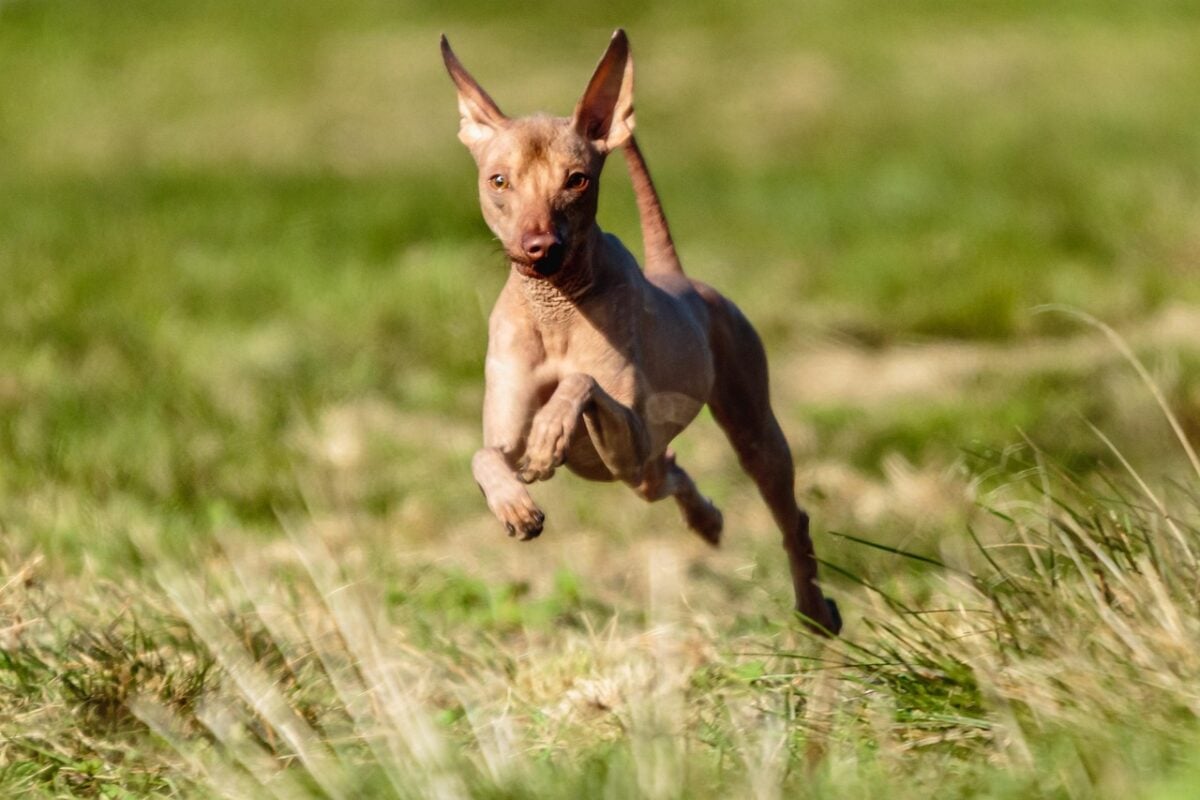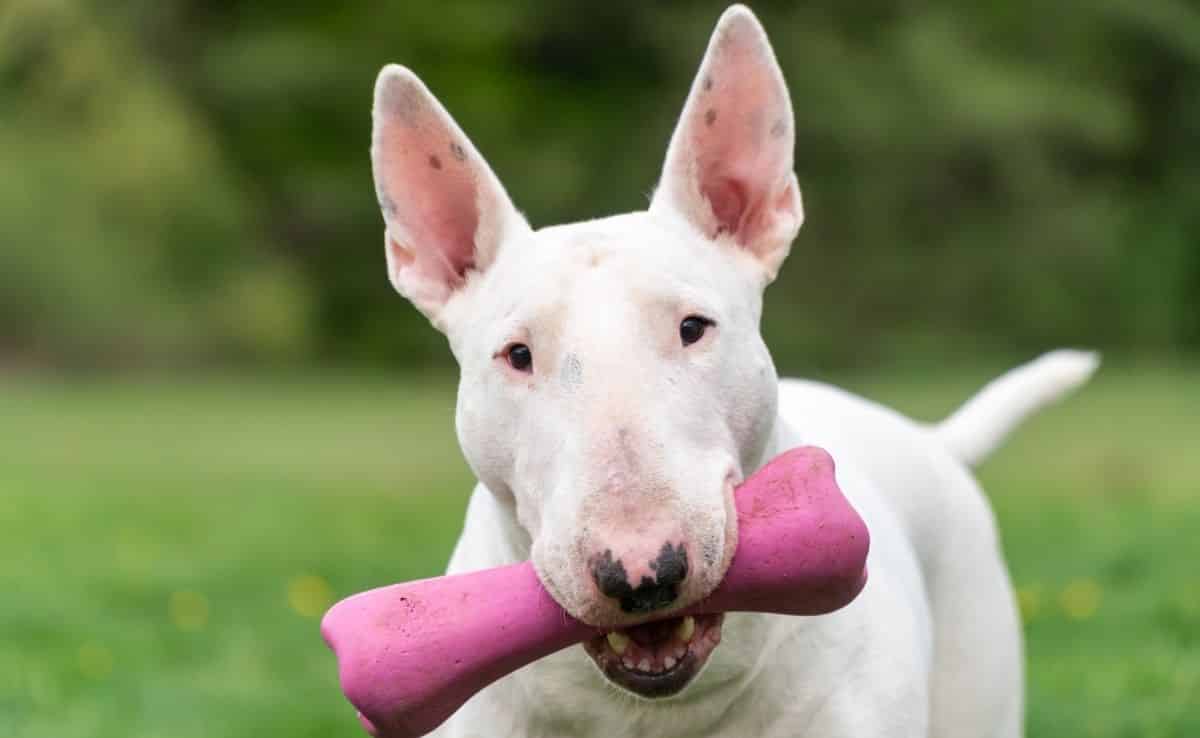10 Hairless Dog Breeds That Put “Naked And Afraid” To Shame
When you purchase through links on our site, we may earn a commission. Here’s how it works.
Not all dogs are born to have fur flying everywhere. Some skip the shedding altogether and rock their smooth skin with pride.
Table of Contents
From ancient temple guardians to modern couch cuddlers, hairless dog breeds have fascinated humans for centuries with their striking looks and surprisingly soft touch. Of course, these unique canines come with one appealing advantage: you’ll never need to own a lint roller again.

Ever Wonder Why Some Dogs Have No Fur?
Natural hairlessness in dogs isn’t just a style choice — it’s rooted in genetics.
Certain breeds carry a mutation in the forkhead box transcription factor (FOXI3) gene, which affects the development of both hair follicles and teeth. That’s why many bald dogs have missing or irregular premolars.
This spontaneous mutation appeared independently in several regions of the world, including the ancient Americas, Africa, and Asia, and was preserved through selective breeding. The result? Distinct lines of hairless dog breeds that share the same smooth look but vary widely in size, temperament, and origin.
Some, like the Xoloitzcuintli, date back thousands of years, while others, such as the American Hairless Terrier, are relatively modern “inventions.”
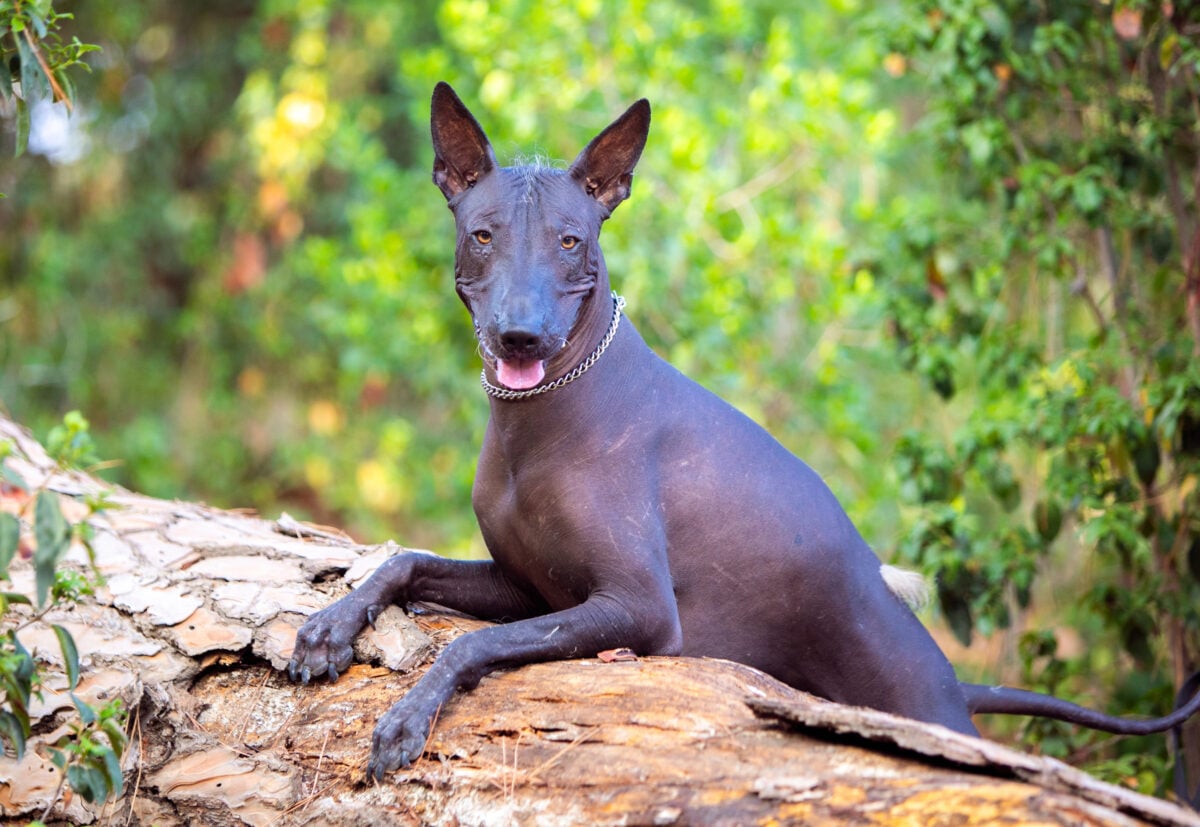
Photo by WoodMarkSib.bigmir.net on Deposit Photos
Behind The DNA That Keeps These Dogs Bald & Beautiful
During fetal development, FOXI3 normally regulates the timing and differentiation of cells that form hair follicles, teeth, and other ectodermal structures. The FOX13 mutation disrupts this regulation, leading to a condition known as canine ectodermal dysplasia and dental abnormalities.
In some breeds, the hairless trait is dominant — a single copy is enough to produce smooth skin, as seen in the Chinese Crested and Xoloitzcuintli. In the American Hairless Terrier, the gene is recessive, meaning that both parents must carry it for puppies to be born bald.
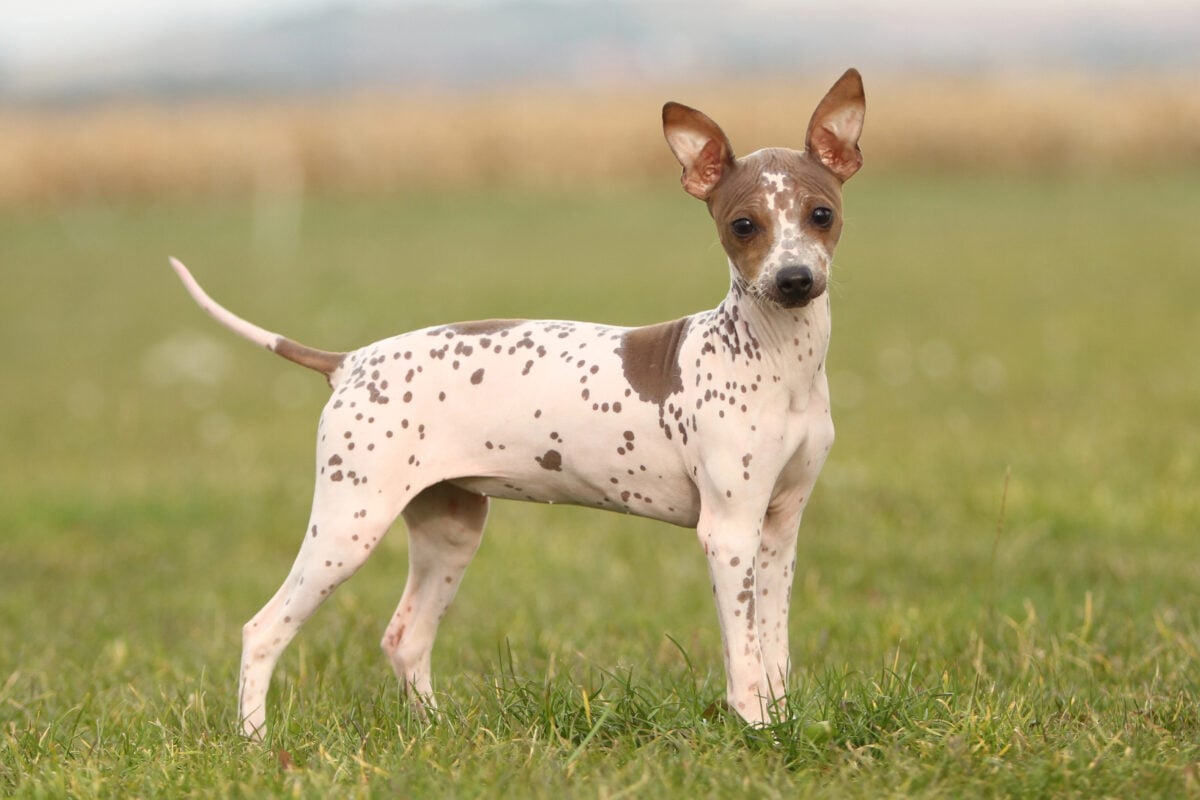
Photo by riha.martin13 on Deposit Photos
Because this mutation impacts more than coat growth, breeders have learned to balance its benefits with potential sensitivities. Over time, selective breeding helped strengthen these lines, ensuring that hairless dogs remain healthy, hardy, and affectionate companions.
Did You Know?
The same FOXI3 gene that causes hairlessness also affects a dog’s teeth, which is why many bald breeds have missing premolars or unusual smiles. It’s not a flaw, just genetics doing its thing.
From Science to Misconceptions
Now that we know why some dogs are hairless, it’s time to tackle the myths that follow them. Many people assume bald dogs are easier to care for or are completely hypoallergenic, but that’s not quite true. Let’s separate fact from fiction.
Myth vs. Reality: What Hairless Dogs Are Really Like
These sleek-skinned pups attract plenty of curiosity — and a few misunderstandings. Here are some of the biggest myths, busted:
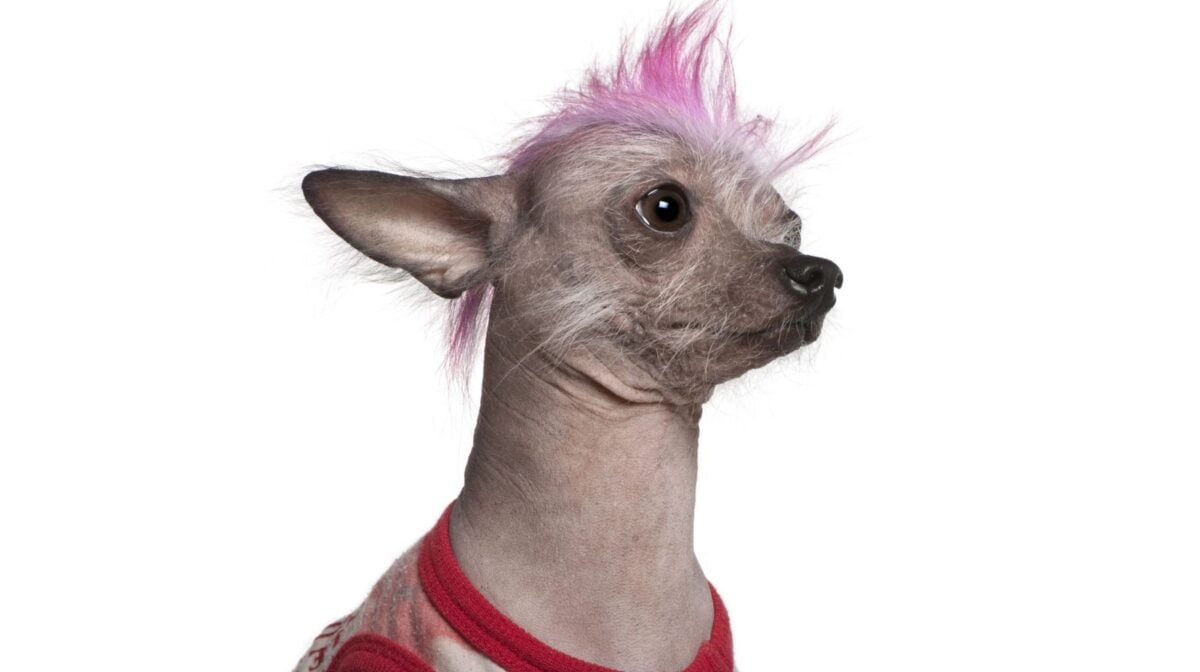
- “They don’t shed at all.”
They still shed skin cells and oils, so regular baths are essential. - “They’re completely hypoallergenic.”
Dander, not fur, causes allergies. Some people do better with hairless dogs, but there’s no guarantee. - “They don’t need grooming.”
No brushing required, but they need skincare routines and dog sunscreen instead. - “They’re fragile.”
Many bald breeds are sturdy, athletic, and tougher than they look. - “They’re new designer breeds.”
Quite the opposite — some, like the Xoloitzcuintli, are among the oldest domesticated dogs on Earth.
Discover 10 Hairless Dog Breeds From Around The World
Each of these dogs proves that you don’t need a fluffy coat to have personality, charm, or loyalty. What they lack in fur, they make up for in affection, intelligence, and uniqueness.
1. Chinese Crested
Part fashion model, part goofball with a spunky attitude, the Chinese Crested is instantly recognizable thanks to its silky crest of hair on its head, extremities, and plume-like tail. Despite its name, the breed likely originated from African or Mexican hairless dogs and was refined by Chinese traders centuries ago.

These dogs love to be the center of attention and form strong, almost clingy bonds with their people. They’re playful, affectionate, and surprisingly agile — often seen perched on the back of a couch like a cat. The Chinese Crested is by far the most popular hairless breed worldwide, known for its show-ring flair and family-friendly size.
Quick Facts:
- Origin: China (via Africa/Mexico)
- Temperament: Lively, affectionate, quirky
- Size: Small
- Exercise Needs: Moderate — short daily walks and playtime
- Why You’ll Love Them: They’re cheerful, loving comedians who adore being near you
2. American Hairless Terrier
The only hairless dog breed native to the U.S., the American Hairless Terrier (AHT) originated as a spontaneous mutation in a Rat Terrier litter in the 1970s. Breeders preserved the line, creating a lively, loyal, and allergy-friendly companion that’s now officially recognized by the American Kennel Club.

AHTs are intelligent, trainable, and full of playful determination — always ready for agility, fetch, or digging sessions. Their friendly, adaptable nature makes them great family pets. The breed is gaining popularity in North America for its lively personality and low-maintenance coat, though it’s still rare compared to mainstream terriers.
Quick Facts:
- Origin: United States
- Temperament: Energetic, intelligent, curious
- Size: Small
- Exercise Needs: High — loves play, agility, and activity
- Why You’ll Love Them: A fun-sized athlete who’s always up for an adventure
3. Xoloitzcuintli (Mexican Hairless Dog)
One of the world’s oldest breeds, the Xoloitzcuintli (pronounced show-low-eats-QUEENT-lee and named for the Aztec god Xolotl) dates back more than 3,000 years. The Aztecs revered the Xolo as a spiritual guardian, believed to guide souls to the afterlife. Today, this “dog of the gods” is calm, watchful, and fiercely loyal.

Its smooth, warm skin and dignified presence make it both striking and affectionate. The Xolo is moderately popular in Mexico and parts of the U.S., thanks to its AKC recognition and ancient heritage, though still rare compared to coated breeds. Available in toy, miniature, and standard sizes, the Xolo’s leathery skin feels surprisingly warm — earning it the nickname “living hot water bottle.”
Quick Facts:
- Origin: Mexico
- Temperament: Calm, loyal, protective
- Size: Small–Medium
- Exercise Needs: Moderate — daily walks and affection
- Why You’ll Love Them: They radiate warmth, wisdom, and soulful loyalty
4. Peruvian Inca Orchid
Elegant and mysterious, the Peruvian Inca Orchid (PIO) has graced South America for centuries. In fact, Peruvian Hairless Dogs are reported to have been present during the Incan Empire. The breed’s smooth skin can appear in shades of charcoal, bronze, or pink, often decorated with natural freckles.
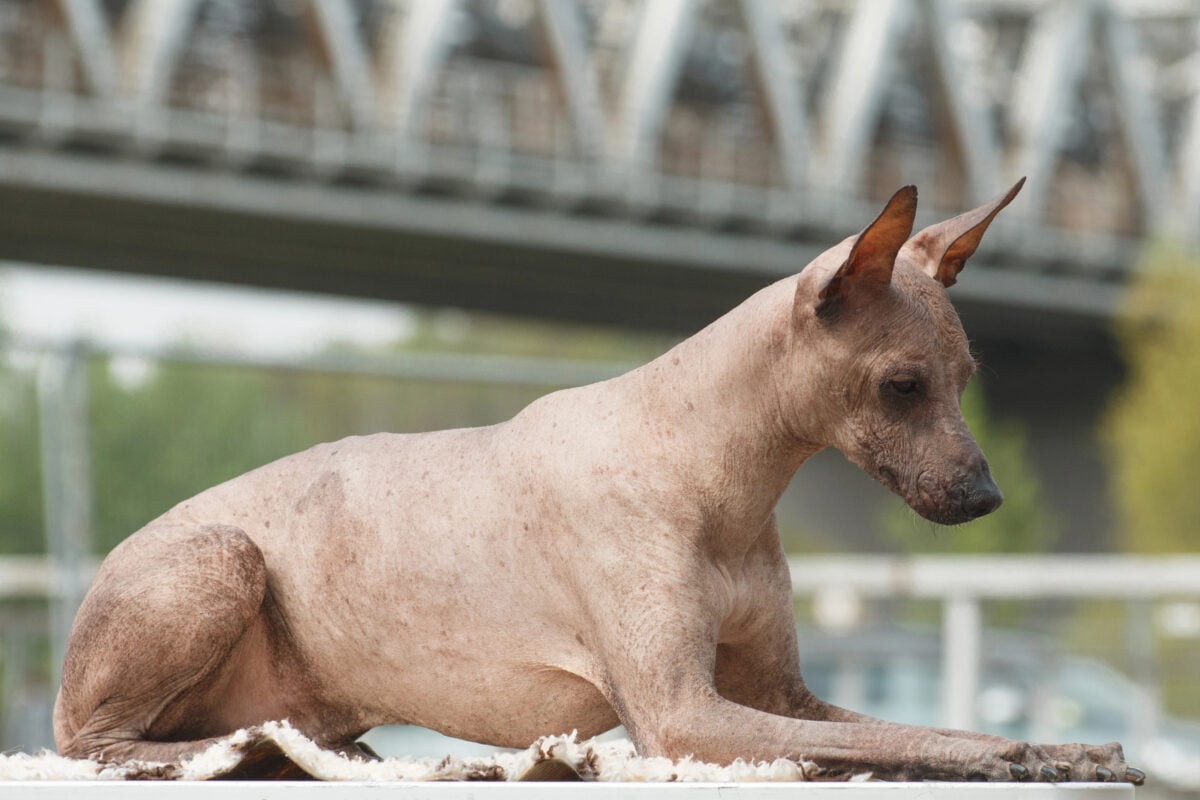
Despite their regal look, PIOs are quick, agile athletes who love sprinting and playing. They’re affectionate but often reserved with strangers. Outside of Peru, the breed remains exceptionally rare, with small preservation efforts in Europe and North America keeping numbers stable.
Quick Facts:
- Origin: Peru
- Temperament: Loyal, graceful, reserved
- Size: Small–Medium
- Exercise Needs: Moderate — loves to sprint and play
- Why You’ll Love Them: They’re elegant companions with deep devotion and quiet charm
5. Hairless Chihuahua
Not an official breed but a rare genetic variation of the classic Chihuahua, the Hairless Chihuahua pops up occasionally in litters. It’s caused by a genetic variation that results in little to no fur, though many retain a few tufts on the head or tail.

These pint-sized pups are feisty, vocal, and full of attitude — tiny watchdogs who love human company and warmth. Their hairless form is highly uncommon, even among dedicated Chihuahua breeders, and they’re prized by collectors and enthusiasts for their rarity.
Quick Facts:
- Origin: Mexico
- Temperament: Bold, loving, attention-seeking
- Size: Toy
- Exercise Needs: Low — short walks and playtime indoors
- Why You’ll Love Them: A fearless heart in the tiniest, coziest package
6. Argentine Pila Dog
The Argentine Pila Dog is South America’s best-kept secret, with skin so soft it’s often compared to suede. Bred for companionship, Pilas are affectionate, loyal, and intelligent, thriving in close family settings.

They’re curious explorers with a playful streak but also love quiet time with their favorite person. Outside Argentina, this breed is extremely rare, with only a few known breeders maintaining the line.
Quick Facts:
- Origin: Argentina
- Temperament: Affectionate, alert, playful
- Size: Small–Medium
- Exercise Needs: Moderate — daily play and walks
- Why You’ll Love Them: A soft, velvety cuddle buddy who loves unconditionally
7. Hairless Khala (Bolivian Hairless Dog)
The Hairless Khala, found mainly in Bolivia, is graceful yet powerful. Believed to descend from ancient Peruvian and Mexican hairless dogs, it comes in two varieties: Khala Medio (medium) and Khala Grande (large).

Protective yet tender with family, the Khala is known for its intelligence and loyalty. It’s one of the rarest hairless breeds, rarely seen outside its native region. Dedicated preservationists in South America work to keep this elegant lineage alive.
Quick Facts:
- Origin: Bolivia
- Temperament: Devoted, protective, intelligent
- Size: Medium–Large
- Exercise Needs: Moderate — walks and secure yard time
- Why You’ll Love Them: A graceful guardian with regal looks and endless devotion
8. Jonangi
Native to India’s southeastern coast, the Jonangi once served fishermen and herders. Known for its smooth coat (and occasional hairless version), it nearly vanished in the late 20th century as traditional uses declined.

Agile, intelligent, and independent, Jonangis thrive on activity and mental challenges. Though a few conservationists are reestablishing the breed, it remains rare outside of rural India — a living relic of regional heritage.
Quick Facts:
- Origin: India
- Temperament: Loyal, athletic, intelligent
- Size: Medium
- Exercise Needs: High — needs space and activity
- Why You’ll Love Them: A loyal, one-of-a-kind companion with a heart as big as their spirit
9. Abyssinian Sand Terrier
Also known as the African Hairless Dog, the Abyssinian Sand Terrier is one of the oldest known bald breeds, believed to have guarded homes and livestock in ancient Africa. Some experts say this breed is extinct, while others claim it still exists in very remote parts of Africa.
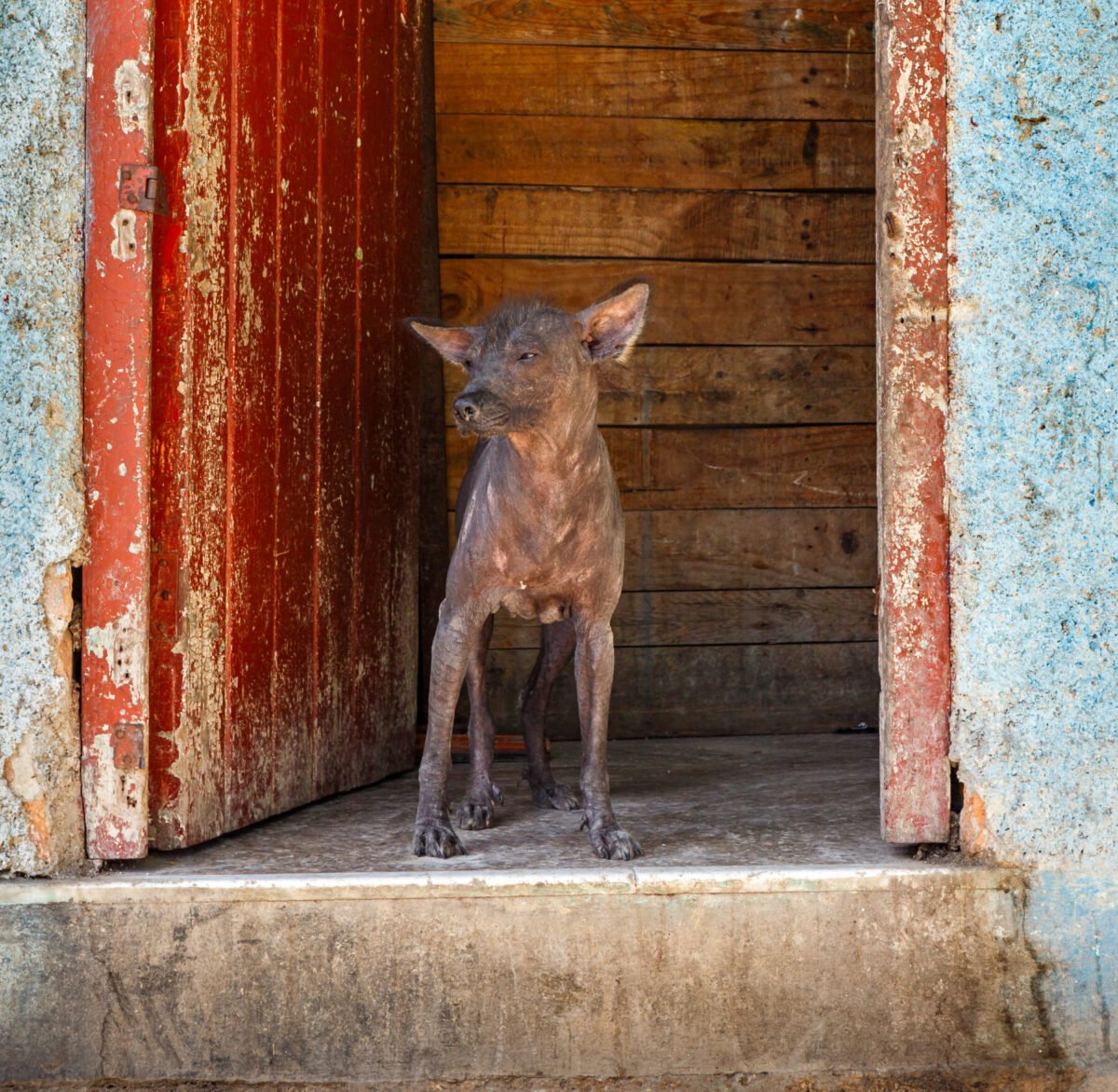
Calm and loyal, they’re excellent watchdogs but gentle with their families. Their rarity within and outside of Africa makes them more of a legend than a common pet, but they represent one of the oldest examples of natural canine hairlessness.
Quick Facts:
- Origin: Africa (Abyssinian region)
- Temperament: Calm, loyal, watchful
- Size: Medium
- Exercise Needs: Moderate — loves a fenced yard and companionship
- Why You’ll Love Them: A wise, low-drama friend who bonds deeply and protects quietly
10. Ecuadorian Hairless Dog
The Ecuadorian Hairless Dog shares ancestry with the Peruvian Inca Orchid, but takes baldness to a new level — it’s almost entirely hair-free. This breed also lacks premolars, giving it a distinct look and gentle, reserved expression.
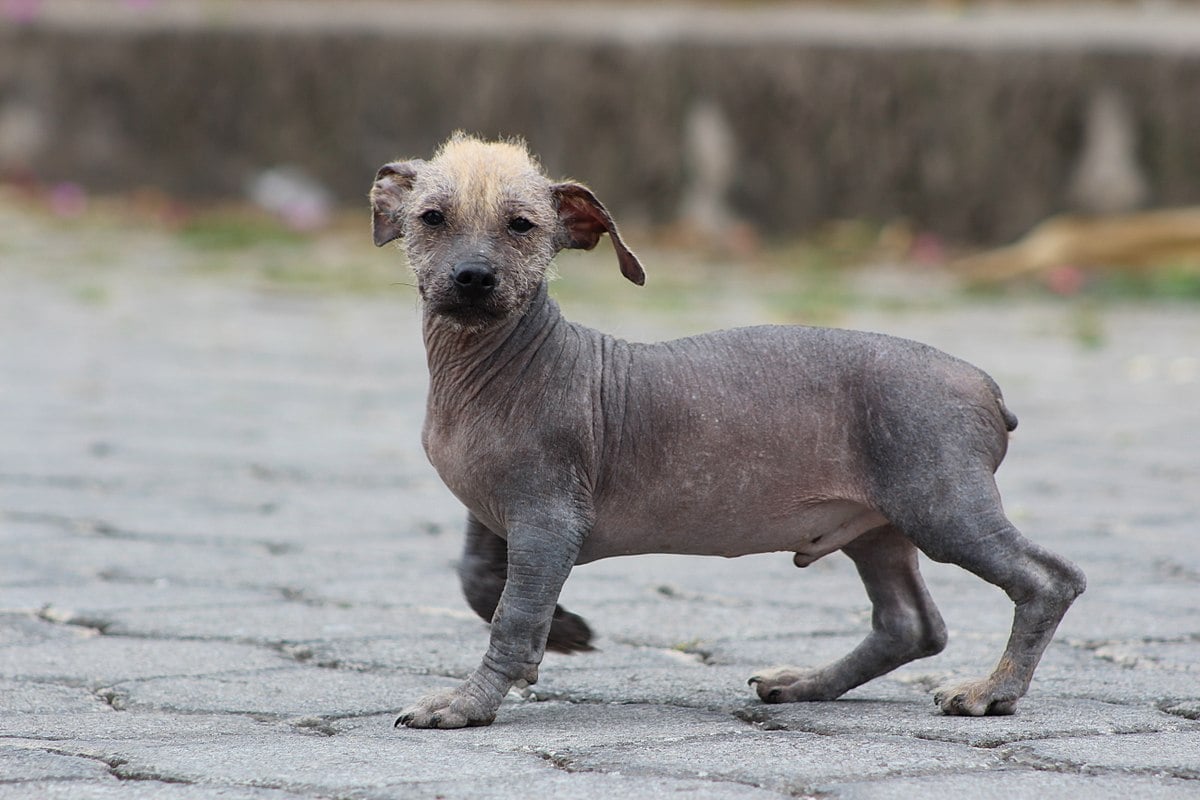
Quiet, sensitive, and loyal, these dogs bond intensely with their owners and prefer calm homes. With only a handful remaining in Ecuador, it’s considered one of the rarest living dog breeds worldwide and is protected through small conservation programs.
Quick Facts:
- Origin: Ecuador
- Temperament: Sensitive, loyal, intelligent
- Size: Medium
- Exercise Needs: Moderate — needs social time and mental stimulation
- Why You’ll Love Them: Their quiet devotion and silky skin make them unforgettable
A Brief History Of Bald Dogs Around The World
Before we get into the extinct breeds, it helps to know just how far these unique dogs have traveled and how ancient their roots really are. Even Charles Darwin wrote about “naked Turkish dogs with missing teeth,” noting how these rare canines captured human curiosity for centuries.
Quick History Facts About Hairless Dogs
- Oldest Known Lineage: The Xoloitzcuintli, dating back over 3,000 years in ancient Mexico.
- Sacred Purpose: The Aztecs believed Xolos guided souls safely into the afterlife.
- Incan Companions: Peruvian Hairless Dogs appear in ancient Incan pottery and tombs.
- Global Origins: Hairless dogs similar to those found in China, Africa, and South America emerged long before modern trade.
- Lost & Found: Several breeds vanished or went unrecognized for decades, until they were revived in Mexico and Europe in the 20th century.
Both Chinese and South American hairless dogs existed before European colonization, though how they became so widespread is still a mystery. Some experts credit early trade or migration across the Bering Strait — others think people simply confused similar hairless types.
In Mexico, the Xoloitzcuintli was sacred to the Aztecs, believed to guide souls into the afterlife. In Peru, hairless dogs lived alongside the Incan Empire and were depicted on ancient pottery. The Chinese Crested may share ancestry with African hairless dogs, but centuries of unrecorded breeding blurred those bloodlines.
By the early 1900s, inconsistent records led to several of these breeds being removed from official registries. It wasn’t until dedicated breeders in Mexico and Europe stepped in that hairless dogs regained recognition.
Today, just a few hairless breeds remain formally recognized, including the American Hairless Terrier, Chinese Crested, Xoloitzcuintli, and Peruvian Inca Orchid, while others like the Argentine Pila, Hairless Khala, and Ecuadorian Hairless Dog remain regional rarities.
Ancient Origins
Archaeologists have uncovered figurines and skeletal remains of hairless dogs in the tombs of various ancient cultures, including the Aztec, Mayan, Toltec, and those in Peru, dating back over 3,000 years. It’s believed that these smooth-skinned companions were often buried with their owners to help guide souls into the afterlife.
Lost To Time: Extinct Hairless Dog Breeds
Not every bald beauty made it to the modern day. Over the centuries, a few hairless dog breeds have vanished — leaving behind little more than sketches, travel journals, and ancient artifacts.

Turkish Hairless Dog
Travelers described this pale-skinned dog as friendly and social, but no living examples or breeding records survive. It may have vanished with the decline of local rural populations that once kept them.
Egyptian Hairless Dog
Rumored to have existed alongside ancient sighthounds, this breed’s details remain fuzzy. Some historians think it was simply a regional variety of the Abyssinian Sand Terrier rather than a distinct type.
Pre-Incan Hairless Dogs
Archaeologists in Peru and Ecuador have found ancient remains of smooth-skinned canines buried in ceremonial tombs. These dogs likely gave rise to the Peruvian Inca Orchid and Ecuadorian Hairless Dog we know today.
Together, these lost lineages remind us how fragile genetics can be — and how close we came to losing hairlessness entirely. Every bald dog alive today carries a living link to those forgotten companions of the past.
The Personality Traits That Make Hairless Dogs Irresistible
Though each breed has its quirks, bald dogs tend to share a few standout traits:
- Affectionate & Loyal: They bond deeply and prefer close contact with their humans.
- Sensitive: They respond best to calm, consistent training and gentle voices.
- Alert but Not Aggressive: Many make good watchdogs without being barky.
- Indoor-Oriented: They enjoy the couch life and prefer moderate climates.
- Low Odor: With no fur to trap smells, they stay fresher longer.
Their mix of brains, heart, and style makes them unforgettable companions, even if they occasionally steal your blanket.
Love at First Touch
Most people are surprised that hairless dogs feel warm and silky, not rough. Their body temperature runs slightly higher than coated breeds — perfect for cuddling on chilly nights.
What It’s Like To Have A Bald Best Friend
Owning a bald dog feels a little like having a living hot-water bottle that follows you everywhere. These dogs are famously affectionate, often preferring to burrow under blankets or press against you for warmth.

Because they lack an insulating coat, they’re indoor companions by nature. Expect them to nap in sunny spots, snuggle under covers, and wear sweaters when the temperature dips.
They also draw plenty of attention in public — strangers love to ask questions, so early socialization helps them handle curious onlookers. Most are sensitive to harsh tones and thrive on gentle training methods and positive attention.
While their skincare needs take a bit of getting used to, most owners say the trade-off is worth it: less shedding, less odor, and a dog who’s always ready for cuddles.
Are Bald Dogs Hypoallergenic?
That’s one of the biggest myths in the dog world.

While it might seem logical that dogs with no hair would trigger fewer allergies, it’s not the fur that causes allergic reactions — it’s the dander (tiny flakes of skin) and saliva proteins.
Hairless breeds do tend to shed less dander because they have less surface area for allergens to cling to, but they’re not truly hypoallergenic. That said, many allergy sufferers find these breeds easier to live with, especially if they’re bathed regularly to remove skin oils and dead cells.
So, “hypoallergenic?” Not exactly. “Easier on the sinuses?” For some, absolutely.
No Fur, No Problem: How To Care For A Hairless Dog
Having a dog with no hair doesn’t mean zero maintenance; it just means different maintenance. Their skin needs the same attention that fur usually requires.
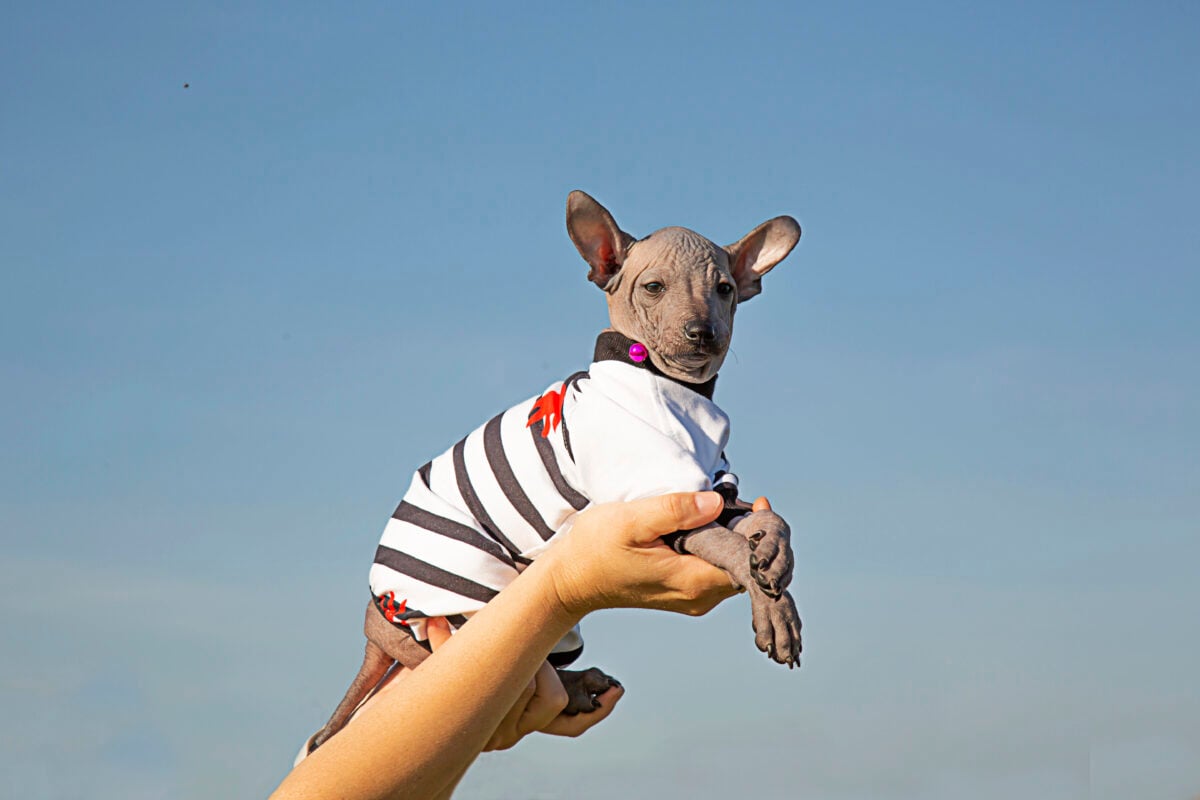
Sun Protection
Hairless dogs are vulnerable to sunburn, especially those with pink or light skin. Limit direct sun exposure and use dog-safe sunscreen on sensitive areas like the nose, ears, and back when going outside. Lightweight dog shirts or rash guards also help prevent UV damage.
Pro Tip: Skip Human Sunscreen
Regular sunscreen can contain zinc oxide and chemicals toxic to dogs. Always choose a pet-safe formula and reapply during long sun sessions.
Cold Weather Protection
Without fur, these dogs get cold fast. Dog sweaters, jackets, and cozy blankets are essential during winter. Even short trips outside can be uncomfortable, so keep outdoor time brief when temperatures drop.
Pro tip: A heated dog bed can make a big difference on chilly nights.
Grooming Needs
It may sound funny, but hairless dogs still need grooming. Their skin produces oils that must be washed away regularly to prevent breakouts. Gentle dog shampoos and moisturizing lotions keep skin soft and healthy.
Avoid human products as they can upset your dog’s natural pH balance and cause irritation.
Healthcare Considerations
Because of their unique genetics, many hairless dogs are missing some teeth or have sensitive skin. Regular vet checkups help catch early signs of dental or dermatological issues.
Skin infections, rashes, and acne can occur if the skin isn’t cleaned properly. Most owners find that a simple weekly skin routine keeps things under control.
Consider Getting Pet Insurance
Unexpected vet bills can pop up at any time, and hairless breeds can be prone to skin sensitivities, dental problems, and autoimmune conditions. Pet insurance can help cover those costs and typically includes coverage for many hereditary and congenital conditions.
If you’re considering one of these rare breeds, explore our expert’s guide to the best pet insurance plans before adopting. Just keep in mind, that insurers typicall don’t cover pre-existing conditions, so it’s best to get a policy as early as possible.
Where To Find Hairless Dogs
Because many hairless dog breeds are rare, finding one may take patience and research. Start with official breed clubs or reputable breeders recognized by national kennel organizations. Look for health testing that screens for dental and skin issues, and always ask about temperament and socialization.
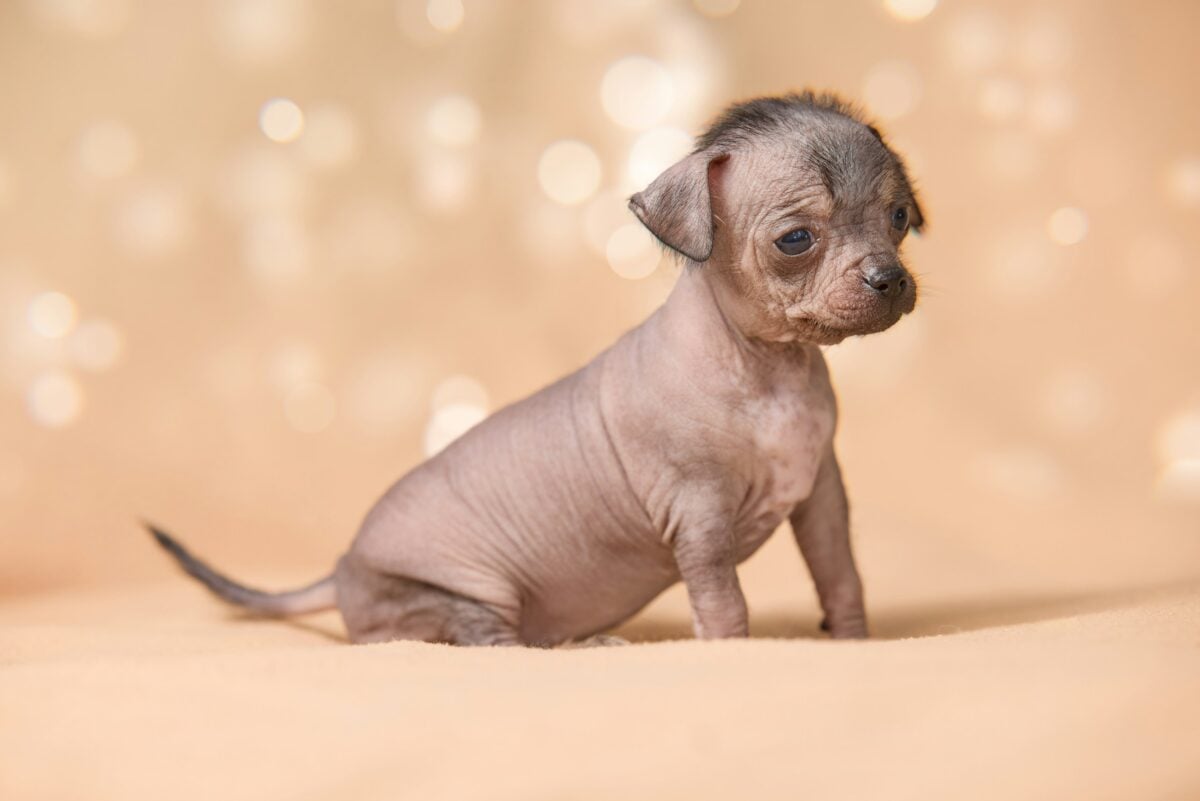
If you’re open to adoption, check Xoloitzcuintli, American Hairless Terrier, or Chinese Crested rescue networks. You might also find mixes with similar traits through general dog rescue groups.
Avoid purchasing from online listings or unverified sellers — ethical breeders focus on the breed’s wellbeing, not novelty. A bit of research up front ensures you’ll bring home a healthy, confident bald beauty.
A Few Helpful Resources
- American Chinese Crested Club
- American Hairless Terrier Club of America
- The Xoloitzcuintli Club of America
- The Peruvian Inca Orchid Club of the United States
Frequently Asked Questions
Still curious about life with a bald best friend? These sleek pups spark a lot of questions about care, comfort, and quirks. We’ve answered some of the most common ones below, but if you’ve got a question we missed, drop it in the comments at the end of this article — our team (and fellow readers!) would love to help.
Are Hairless Dogs Hypoallergenic?
It’s a common misconception, but “hairless” doesn’t mean allergen-free. Dander, not fur, causes most allergic reactions. However, many allergy sufferers find these dogs easier to live with, especially if they’re bathed regularly to remove skin oils and dead cells.
Do Hairless Dogs Smell Less Than Coated Breeds?
Usually, yes! Because they lack fur to trap oils and debris, hairless dogs tend to have very little odor. A quick weekly bath keeps them fresh and cuddle-ready.
How Do Bald Dogs Handle Temperature Extremes?
They’re sensitive to both heat and cold. In summer, keep them shaded, hydrated, and protected from sunburn. In winter, bundle them up and avoid long outdoor sessions. Most hairless dogs prefer a cozy, climate-controlled home environment.
Do Dogs With No Hair Require Special Skin Care?
Yes. Their skin needs regular cleansing to remove oils and dirt, plus moisturizing to prevent flakiness or irritation. Bathing once a week with a gentle dog shampoo works well. Always avoid harsh soaps or products made for humans.
Are Hairless Dogs Prone to Specific Health Issues?
They can be, depending on the breed. Missing teeth, acne, and occasional skin allergies are common. Most of these are manageable with good hygiene, nutrition, and routine veterinary care. Regular sunscreen use and daily dental cleanings go a long way toward keeping them healthy.
Are Hairless Dogs Good With Kids or Other Pets?
Yes — most are affectionate and people-oriented. They bond closely with their families and often get along well with other pets. Just teach children gentle handling since their skin can be sensitive to rough play.
More Dogs With Fun Features
If you’re looking for a loyal companion who turns heads everywhere they go, hairless dog breeds might just be your new obsession. Curious about pups with standout features? Explore our guides to non-shedding breeds, stumpy-tail dog breeds, and wrinkly dog breeds next.
Thinking about adding a bald beauty to your family? Or already living with one of these smooth-skinned sweethearts? Share your experience or questions in the comments below — we love hearing your stories!
